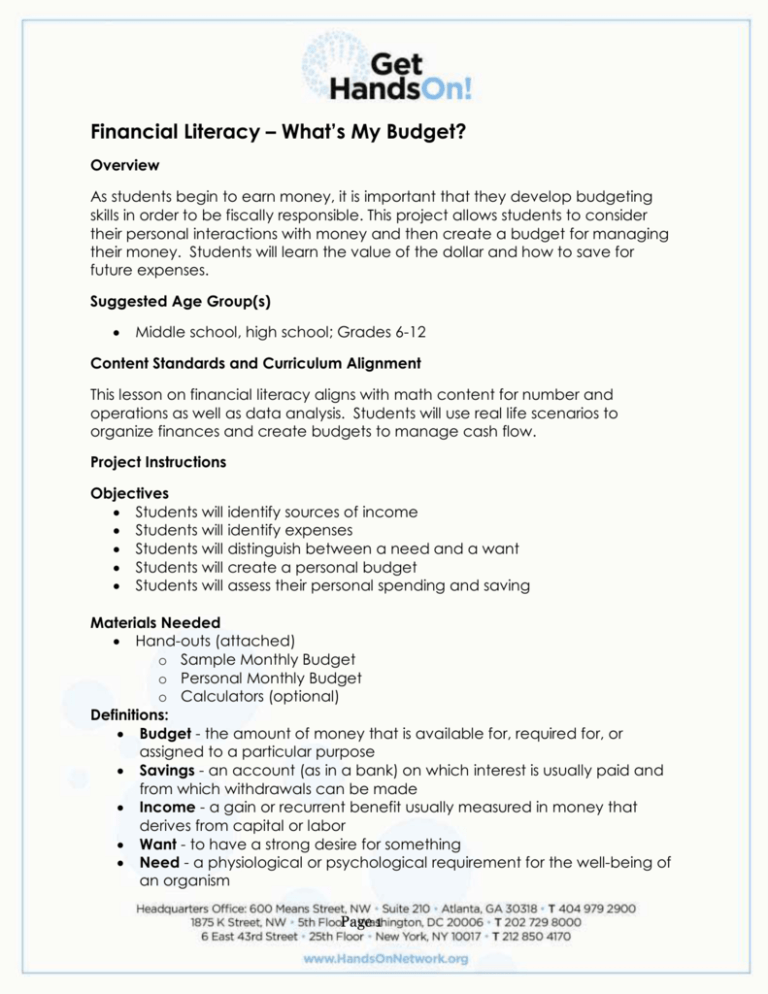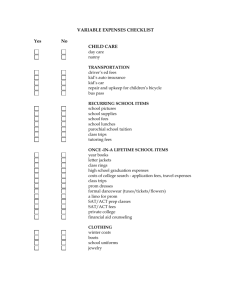Financial Literacy – What's My Budget?
advertisement

Financial Literacy – What’s My Budget? Overview As students begin to earn money, it is important that they develop budgeting skills in order to be fiscally responsible. This project allows students to consider their personal interactions with money and then create a budget for managing their money. Students will learn the value of the dollar and how to save for future expenses. Suggested Age Group(s) • Middle school, high school; Grades 6-12 Content Standards and Curriculum Alignment This lesson on financial literacy aligns with math content for number and operations as well as data analysis. Students will use real life scenarios to organize finances and create budgets to manage cash flow. Project Instructions Objectives • Students will identify sources of income • Students will identify expenses • Students will distinguish between a need and a want • Students will create a personal budget • Students will assess their personal spending and saving Materials Needed • Hand-outs (attached) o Sample Monthly Budget o Personal Monthly Budget o Calculators (optional) Definitions: • Budget - the amount of money that is available for, required for, or assigned to a particular purpose • Savings - an account (as in a bank) on which interest is usually paid and from which withdrawals can be made • Income - a gain or recurrent benefit usually measured in money that derives from capital or labor • Want - to have a strong desire for something • Need - a physiological or psychological requirement for the well-being of an organism Page 1 • • Expenses - financial burden or outlay: cost or charge Credit - an amount or sum placed at a person's disposal by a bank or other entity Page 2 • • • Credit Card - a card authorizing purchases on credit Credit Rating - an estimate, based on previous dealings, of a person's or an organization's ability to fulfill financial commitments Interest - a fee paid on borrowed assets Lesson • Ask students to share what they know about creating a budget. Hold a discussion with students on what it means to save money. Ask some of the following questions to start the conversation: • Does anyone have a steady source of income (job or allowance)? What do you do with your money when you get it? • Do you spend money or save money? • Does anyone know the difference between a want and a need? o A want can often be confused with a need. A want is something that would be nice, but you can live without. This might include items such as movie tickets, candy, soda, video games, DVDs, books, and so on. o A need is something that you must have in order to live your daily life. This includes food, shelter, water, clean clothes, and so on. • What are some wants and needs that you spend money on? • Does anyone keep track of his or her spending? Does anyone keep a budget? • What are strategies you use to follow your spending habits? • Inform students that it is important to understand how to track spending and saving properly. Explain that keeping a budget can help avoid debt. Keeping a budget can also help save in order to buy important unexpected items, such as medicine. Saving money can also help purchase more expensive items in the future. • What to look out for: Inform students that it is important to understand credit cards before applying for them. Improperly applying for and not paying off credit cards can ruin a person’s credit rating. Some credit cards have very high interest rates and make it hard to pay them off. It is important to maintain a good credit rating in order to apply for future credit cards, school loans, home loans, and car loans. It is also important not to apply for or hold too many credit cards at once. They can be hard to manage and will also lower your credit rating. This includes credit cards from clothing and department stores. Page 3 • Present students with the Sample Monthly Budget (see attached). This sample budget will give students an idea of how to create a basic spreadsheet for controlling expenses and documenting income. Ask for students to share what they find interesting about the budget. Encourage students to ask questions. Ask them if this budget can be changed to save even more money. What are the wants and needs in this budget? • If time permits, present students with 15 Money Making Rules Kids Should Learn (found under additional resources). Project • Hand out the Personal Monthly Budget form (see attached). Ask students to rank items by their importance by placing a number next to each item. These items need to be paid for first. • Next, ask students to fill out their budget forms to the best of their knowledge (use computers if available). If a student does not have an income, ask him/her still to fill out the form to estimate expenses and how much money he/she spends. Reflection • Ask for students to share their budgets. What was surprising? What was not surprising? Are there items students can live without in order to save more money? What items are needs and what items are wants? • Review: Why is it important to keep a budget and save money? How will you change the way you save and spend now that you know how to keep a budget? • Remind students that some banks allow people to track their spending online. Additional Resources • 15 Money Making Rules Kids Should Learn http://finance.yahoo.com/banking-budgetingk/article/109200/the-15money-rules-kids-should-learn?mod=bb-budgeting Page 4 Sample Checklist Before students arrive, it is important to establish: Where students will work, Where everyone will sit for discussion (maybe put chairs in a circle), Where students will put their backpacks, coats, or other items they want out of the way. Notes If you have volunteers and youth leaders, ask them to help with setup. It is important to establish how the project will run. Will students go directly to materials, or will they go to a place to sit and receive instructions? Ask volunteers and youth leaders to help younger students with their projects. Page 5 Sample Monthly Budget The salary of an employee at Derrick’s Deli is $20,000 annually. After taxes and health insurance, his or her annual income comes to $18,000 (or $1,500 a month). Below is the employee’s monthly budget: Fixed Expenses (prices stay the same month to month): Rent $450 Utilities $50 Telephone $10 Transportation $80 Cable/Internet $55 Total $645 Variable Expenses (these prices fluctuate month to month): Groceries $60 Clothing $30 Medicine $15 Restaurants/fast food $50 Household supplies $30 Entertainment $20 Total $205 Page 6 Comparison Monthly Income $1,500 Fixed Expenses $645 Variable Expenses $205 Total monthly cost $850 Total monthly savings $650 • • Total monthly cost is found by adding fixed expenses and variable expenses. Total monthly savings is found by subtracting total monthly cost from monthly income. According to this budget, an employee can save approximately $660.00 per month. These savings will come in handy if the employee needs to travel or pay an unexpected cost such as a doctor’s visit or new tires for the car. This employee does not have a credit card and does not need to worry about monthly credit card bills. Personal Monthly Budget If you have a job or allowance, find the average monthly income. If you do not have a job or allowance, fill out the form to find approximately how much money you spend per month. These numbers do not need to be exact, use your best estimates. Monthly Income: _____________________ Page 7 Approximate Monthly Expenses Clothing Food/Restaurants Entertainment Transportation School/Home supplies Books/Magazines Other: Other: Other: Other: Other: Total Expenses Find your total monthly savings by subtracting your total expenses from your total income. Total Monthly Savings: _________________ Page 8





